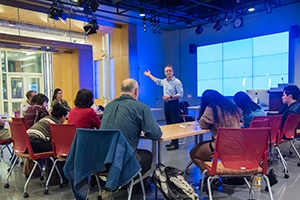SOC Offers Backpack Documentary Class in Spanish
–Gregg Sangillo, Nov 09, 2016

If you’re reporting from a foreign country, you can’t just rely on a translator. Bill Gentile spent many years as a correspondent and photographer in Latin America, and he stresses the need to speak Spanish fluently.
“You can’t get under the skin of a culture, or a people, or a country, if you don’t speak their language. You can communicate with them. You can exchange information with them. But you can’t really discern how they think,” says Gentile, a professor and journalist in residence at American University’s School of Communication.
This semester, Gentile is teaching a new course, Backpack Documentary en Español. That’s exactly what it sounds like: a video journalism course taught entirely in Spanish. It’s the first of its kind in SOC, and its benefits extend beyond the aforementioned work of foreign correspondents.
“Backpack documentary” emphasizes that journalists can tell powerful, intimate stories with hand-held, digital cameras.
Connecting with Communities
Gentile’s course includes both Hispanic and non-Hispanic students. The SOC course is also cross-listed with the World Languages and Cultures Department in the College of Arts and Sciences.
Especially if you’re not a native Spanish speaker, this class can help you stay conversant in the language of a significant and growing demographic in the U.S., Gentile says.
“Whether you’re in journalism, law enforcement, business, or any field, if you speak this language— which is the second most spoken in the country—you’ve got an advantage over people who don’t,” he explains.
Through their film projects, students can also connect with Central American and other Hispanic communities in the D.C. area. For instance, one student is working on a film about the Rumba Café, an Adams Morgan bar and restaurant popular with Latinos. AU World Languages and Cultures Professorial Lecturer Ludy Grandas, also a student in Gentile’s class, is making a short documentary about Antonio de la Cruz, an 89-year-old barber in the Mount Pleasant neighborhood.
Inclusion and Belonging
Gentile is a member and former co-chair of the SOC’s Diversity Committee. By establishing a welcoming environment for Hispanic and Latina/Latino students, he hopes the course will help improve the racial climate on campus.
“I want to be inclusive. And I want there to be a safe space for students who speak the language,” he says. “And it’s not just a safe space, but a space where students feel that they belong.”
Lifelong Learning
As pretty much every AU professor will insist, you never stop learning. Profs talk about stumbling upon the unexpected during a lecture, or how a student’s question forced them to reexamine old assumptions.
While taking Gentile’s class, Grandas is discovering the art of filmmaking. Originally from Colombia, she teaches topics courses in Spanish in CAS. But she had no previous background producing film.
“Making a film is very difficult. Even if it’s just a three-minute documentary, it requires a lot of time,” she says.
Yet Gentile is helping her—and all of his students—throughout the process. He frequently accompanies his students on their film shoots, and Grandas exalts that level of commitment.
“He comes with us to film. He accommodates our schedule. And that is something that is very hard to find in an instructor or a professor,” she says.
She initially wanted to film day laborers at Home Depot in Northeast, D.C. It never came to fruition, though, as they shied away from the camera. So she switched her project to the barber in Mount Pleasant.
She already sees how this course will help with her own teaching, since she’s planning to teach a new class on Latin American cinema.
“It’s very humbling to know that you don’t know so many things,” she says. “It’s learning a new kind of language. It’s a visual language.”
The Universal Language: Visual Storytelling
Ultimately, Gentile says, “visual language” is the key to understanding this course. It’s not a Spanish class and he’s not a Spanish teacher. And comprehending the technology is only a small part of the equation.
“I’m trying to convey to students that they have a voice,” he says. “It’s not about gears, it’s not about equipment, it’s not about any of that stuff. It’s about learning to speak the visual storytelling language.”
When students finish their films, they can put them on YouTube, Vimeo, or other multimedia outlets. Then, of course, almost anybody can watch and draw inspiration.
“For the first time in the history of mankind, we can communicate instantly, globally, and in a language that everybody can understand.”